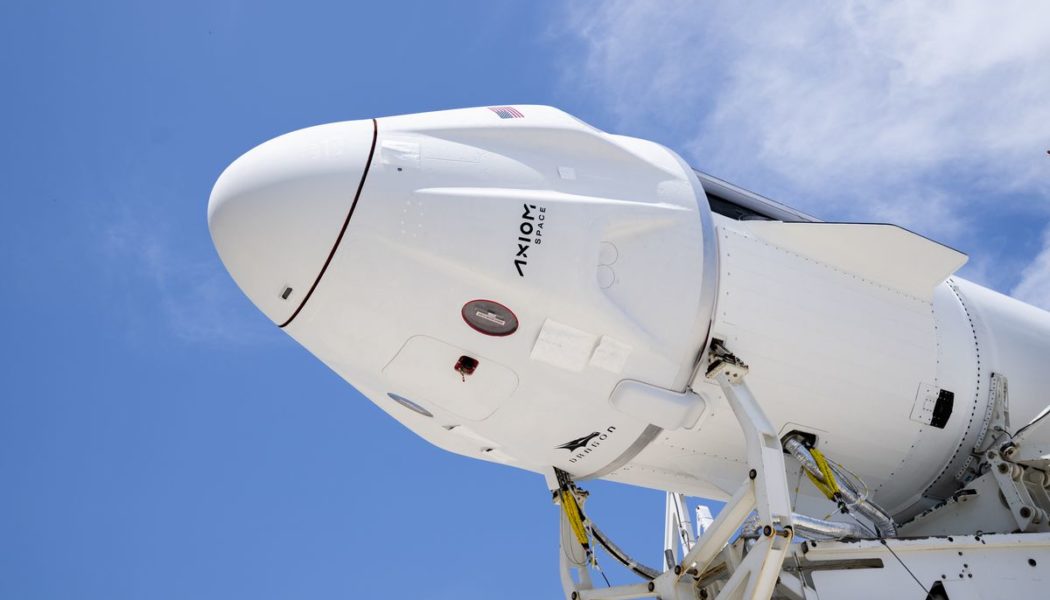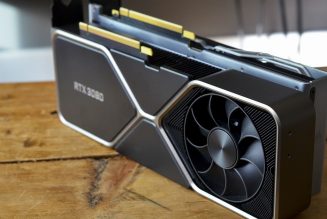Tomorrow morning, SpaceX is set to launch yet another crew of four to the International Space Station from Florida — but unlike most of the company’s passenger flights, this new crop of flyers won’t include any current NASA astronauts. All four members of the crew are civilians, flying with a commercial aerospace company called Axiom Space. Their flight will mark the first time a completely private crew has visited the ISS.
It’s a new type of human spaceflight mission and one that comes with a hefty price tag for its participants. Three of the four flyers have each paid a reported $55 million for their seats on SpaceX’s crew capsule, called the Crew Dragon. The trio of novice spacefarers includes Canadian investor Mark Pathy, American real estate investor Larry Connor, and former Israeli Air Force pilot Eytan Stibbe. The commander of the trip is a spaceflight veteran: Michael López-Alegría, a former NASA astronaut who has flown four missions to space and now serves as a vice president of Axiom.
Their mission, called Ax-1, is the latest in an emerging trend of completely private astronaut flights to orbit. For the bulk of spaceflight history, human spaceflight missions were almost exclusively conducted by government-run space programs. That’s changing as the commercial space industry has leaped forward over the last few decades. At the head of the pack is SpaceX, which has proven it can safely send people to and from low Earth orbit on its Crew Dragon. While SpaceX primarily launches NASA astronauts, the company has started flexing its muscles of late and begun conducting civilian crew flights without NASA’s input.
Civilian flights like these are only going to become more common. Axiom — which strives to create a fleet of commercial space stations — has arranged for three additional private crew missions to the ISS, just like Ax-1, to gear up for the creation of its first station. The company’s goal is to “make space more accessible to everyone.”
“This really does represent the first step where a bunch of individuals who want to do something meaningful in low Earth orbit — that aren’t members of a government — are able to take this opportunity,” Mike Suffredini, Axiom’s CEO and the former program manager of the ISS at NASA, said during a press conference. Though, until costs come down, such individuals will need a fat wallet.
A new paradigm
Axiom is capitalizing on some crucial timing, as SpaceX transitions into a new phase of operation with the Crew Dragon. Originally, SpaceX developed the Crew Dragon for NASA in order to ferry the agency’s astronauts to and from the International Space Station. With an original contract worth $2.6 billion and after more than six years of development, SpaceX successfully launched its first crew on the Crew Dragon in May 2020, sending two NASA astronauts to the ISS.
The ultimate goal for NASA was to offload transportation to the ISS to the private sector, but a secondary goal was for SpaceX to eventually use the capsule to conduct crewed missions of its own. With the Axiom missions, that’s exactly what SpaceX is doing: using the protocols and technology it developed for NASA to build an entirely separate commercial business for human spaceflight.
:no_upscale()/cdn.vox-cdn.com/uploads/chorus_asset/file/23373987/51983862187_8ea41d9dbe_o.jpg)
Coinciding with SpaceX’s Crew Dragon development was a big policy change at NASA. In 2019, NASA announced that it was going to open up the facilities on the International Space Station to more commercial opportunities as well as encourage private astronauts to visit the ISS on US spacecraft. Such activities used to be discouraged, and while wealthy space tourists have visited the station before, all flew on Russian Soyuz vehicles. Now, with this new change, people who booked a flight to the ISS on US spacecraft could potentially use the station’s facilities for commercial activities, such as shooting movies or advertisements.
Of course, using the ISS’s various systems will cost you, just as it would if you were using the fancy amenities at a hotel. According to the agency’s announcement, NASA planned to charge $11,250 per day per person to use the station’s life support system and toilet. Providing provisions like food, medical supplies, and exercise equipment would cost a combined $22,500 per day per person.
With all of these changes, Axiom saw an opportunity. Currently, the company is working to build its first commercial space station, called Axiom Station, with plans to eventually attach the first module of the orbiting outpost to the ISS as early as 2024. They plan to test out the module on the ISS before breaking away and creating the company’s own free-flying station. To prepare for this big step, Axiom turned to SpaceX to conduct a series of precursor missions to the ISS — essentially a series of dress rehearsals for when Axiom sends people to its own space station one day.
“This precursor mission is important, because not only are we developing the techniques that we’re going to be using communicating with the ground to space here in mission control at Axiom, but we’re also developing all the procedures and processes that make a spaceflight possible,” Peggy Whitson, a former NASA astronaut and director of human spaceflight at Axiom, said. Whitson will serve as commander of Axiom’s next mission, Ax-2.
Ax-1 to orbit
The Ax-1 crew will join a number of other wealthy private flyers paying their way to space. Apart from the handful of space tourists who have already visited the station, rich spacefarers have also begun purchasing pricey tickets for rides on suborbital vehicles operated by companies like Blue Origin and Virgin Galactic, allowing them to spend just a few short minutes at the edge of space.
The Ax-1 mission, however, will be much grander in scope than those missions. “Our feeling is with the space tourists, they’ll spend 10 or 15 hours training, 5 to 10 minutes in space,” crew member Larry Connor said. “And by the way, that’s fine. In our case, depending upon our role, we’ve spent anywhere from 750 to over 1,000 hours training.”
Another private SpaceX launch last year, called Inspiration4, sent a private four-person crew into orbit inside a Crew Dragon for about three days — where they enjoyed views out the window and conducted a handful of experiments. Ax-1 will be at the station for eight days, and the crew has a whole suite of space experiments planned. Together, the four flyers will be conducting a total of 25 different science experiments, which will take about 100 hours to complete. These include human physiology experiments for the Mayo Clinic, as well as a two-way 3D hologram demonstration using a Microsoft HoloLens.
The Ax-1 astronauts will primarily be living and working in the US portion of the ISS, though they’ll enter the Russian portion of the station by invitation from the cosmonauts on board. Despite tensions between Russia and the United States, the two countries have continued to work together to maintain daily operations of the ISS. Currently, there are three Russian cosmonauts living on the ISS, three NASA astronauts, and one German astronaut with the European Space Agency.
:no_upscale()/cdn.vox-cdn.com/uploads/chorus_asset/file/23373993/51814919155_080e53e0a3_o.jpg)
Axiom hasn’t provided concrete details on how much this mission will cost, only that they will be paying NASA some amount of money for use of the ISS. “We have to compensate NASA for the use of the ISS and other services, and we have done that,” Suffredini said. He also noted that NASA may knock off some costs in return for Axiom’s services. “There are some things we are doing on this flight that helps NASA out, which we get credit for.” Suffredini also wouldn’t say if Axiom is making a profit on this mission, simply that Ax-1 is in line with the company’s original vision for the mission.
Ax-1 is still something of a watershed moment for the space station, though, given how it is funded and who is onboard. “We are taking the first step in a next generation platform initiative that’s going to bring working, living, and research in space to a much broader and more international audience,” commander López-Alegría said.
Of course, to participate, that audience still needs to have about $55 million to spare for a seat. So while Axiom may be opening up space to more flyers than before, it’s still a relatively small pool to choose from.








